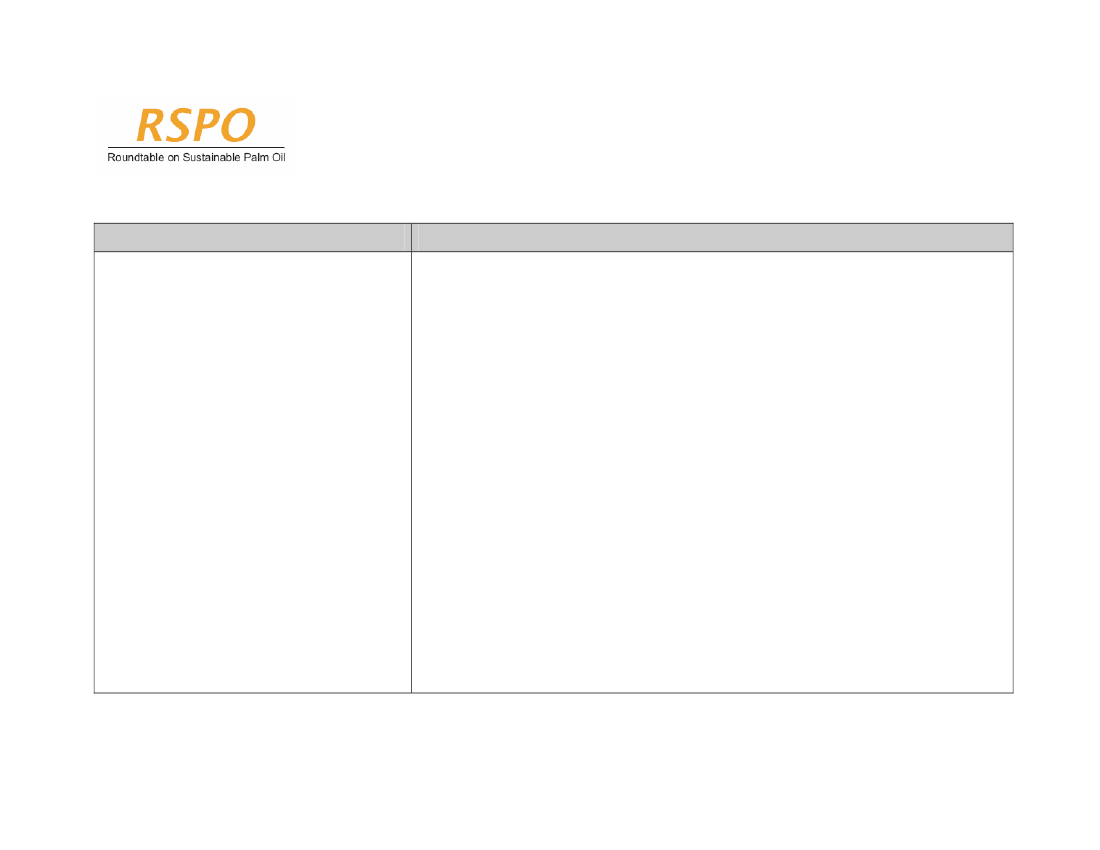Miljø- og Planlægningsudvalget 2010-11 (1. samling)
MPU Alm.del Bilag 96
Offentligt
RSPO Principles and
Criteria for Sustainable
Palm Oil Production
Including Indicators and GuidanceOctober 2007RSPO Principles and Criteria for Sustainable Palm Oil Production. October 2007
Principles and Criteria for Sustainable Palm OilProductionPreambleSustainable palm oil production is comprised of legal, economically viable,environmentally appropriate and socially beneficial management and operations.This is delivered through the application of the following set of principles andcriteria, and the accompanying indicators and guidance.These criteria and guidance were applied for an initial pilot implementation periodup to November 2007, and were reviewed at the end of this period. The objective ofthe pilot implementation period was to enable field testing of the principles andcriteria, and thereby allow guidance to be improved. The development of moredetailed guidance for application of the principles and criteria by smallholders,animportant aspect of this, is still ongoing. During this initial period, nationalinterpretations have also been drafted. .This Document defines indicators and guidance for each criterion. Indicators arespecific pieces of objective evidence that must be in place to demonstrate or verifythat the criterion is being met. Guidance consists of useful information to help thegrower/miller and auditor understand what the criterion means in practice, includingin some cases specific guidance for national interpretation of the criterion and forapplication by smallholders.This document will be completely reviewed within five years. Within that period, theExecutive Board may approve specific amendments.The RSPO Criteria Working Group (CWG) recommend to the Executive Board thatRSPO urgently establish a working group to consider all issues relating toGreenhouse Gas emissions, in terms of their relevance to the oil palm sector. Thismay include the development of amendments to the RSPO Principles, Criteria,Indicators and Guidance, which should then be reviewed within one year afteradoption. The CWG recommend that this Working Group includes a balanced,representative selection of interested parties from the CWG, and co-opts technicalexpertise with specialist knowledge in the field. The Working Group should develop adraft within six months including a public consultation, before submitting anamended text to the Executive Board.The RSPO Criteria Working Group note that RSPO made a commitment in March 2006that a project would be initiated to identify safe and cost effective alternatives toPreamble
2
RSPO Principles and Criteria for Sustainable Palm Oil Production. October 2007
replace chemicals that are categorised as World Health Organisation Type 1A or 1B,or listed by the Stockholm or Rotterdam Conventions, and paraquat. Results were tobe collated and reported by November 2007. The RSPO Criteria Working Group nownotes that this project has not even been commenced, and requests that thissituation is urgently addressed, such that this project is commissioned as soon aspossible, and undertaken with a completion date not later than November 2008.
Preamble
3
RSPO Principles and Criteria for Sustainable Palm Oil Production. October 2007
Principles and Criteria for Sustainable Palm Oil ProductionPrinciple 1: Commitment to transparencyCriterionCriterion 1.1 Oil palm growers and millers provideadequate information to other stakeholders onenvironmental, social and legal issues relevant toRSPO Criteria, in appropriate languages & forms toallow for effective participation in decision making.Indicators and GuidanceIndicators:Records of requests and responses must be maintained.Guidance:Growers and millers should respond constructively and promptly to requests forinformation from stakeholders.See criterion 1.2 for requirements relating to publicly available documentation.See also criterion 6.2 relating to consultation.Criterion 1.2 Management documents are publiclyavailable, except where this is prevented bycommercial confidentiality or where disclosure ofinformation would result in negative environmentalor social outcomes.Indicators:This concerns management documents relating to environmental, social and legalissues that are relevant to compliance with RSPO Criteria. Documents that must bepublicly available include, but are not necessarily limited to:•••Land titles/user rights (criterion 2.2).Health and safety plan (4.7).Plans and impact assessments relating to environmental and social impacts (5.1,
Guidance for Principle 1: Commitment to transparency
4
RSPO Principles and Criteria for Sustainable Palm Oil Production. October 2007
6.1, 7.1, 7.3).••••Pollution prevention plans (5.6).Details of complaints and grievances (6.3).Negotiation procedures (6.4).Continuous improvement plan (8.1).
Guidance:Examples of commercially confidential information include financial data such as costsand income, and details relating to customers and/or suppliers. Data that affectspersonal privacy should also be confidential.Examples of information where disclosure could result in potential negativeenvironmental or social outcomes include information on sites of rare species wheredisclosure could increase the risk of hunting or capture for trade, or sacred siteswhich a community wish to maintain as private.For national interpretation, specific approaches to personal privacy safeguards,including any legal requirements, should be considered.
Guidance for Principle 1: Commitment to transparency
5
RSPO Principles and Criteria for Sustainable Palm Oil Production. October 2007
Principle 2: Compliance with applicable laws and regulationsCriterionCriterion 2.1 There is compliance with allapplicable local, national and ratifiedinternational laws and regulations.Indicators and GuidanceIndicators:••••Evidence of compliance with relevant legal requirements.A documented system, which includes written information on legal requirements.A mechanism for ensuring that they are implemented.A system for tracking any changes in the law.
The systems used should be appropriate to the scale of the organisation.Guidance:Implementing all legal requirements is an essential baseline requirement for all growerswhatever their location or size. Relevant legislation includes, but is not limited to,regulations governing land tenure and land-use rights, labour, agricultural practices (e.g.,chemical use), environment (e.g., wildlife laws, pollution, environmental management andforestry laws), storage, transportation and processing practices. It also includes laws madepursuant to a country’s obligations under international laws or conventions (e.g. theConvention on Biodiversity, CBD). Furthermore, where countries have provisions to respectcustomary law, these must be taken into account.For small-scale producers the focus should be on the grower having adequate knowledge ofthe main legal requirements and implementing them.Key international laws and conventions are set out in Annex 1.[amendedto include UN
Guidance for Principle 2: Compliance with applicable laws and regulations
6
RSPO Principles and Criteria for Sustainable Palm Oil Production. October 2007
Declaration on Rights of Indigenous people]For national interpretation, all relevant legislation should be identified, and any particularlyimportant requirements identified. Contradictions and inconsistencies should be identifiedand solutions suggested.Criterion 2.2 The right to use the land can bedemonstrated, and is not legitimatelycontested by local communities withdemonstrable rights.••Indicators:•Documents showing legal ownership or lease, history of land tenure and the actual legaluse of the land.Evidence that legal boundaries are clearly demarcated and visibly maintained.Where there are, or have been, disputes, additional proof of legal acquisition of title andthat fair compensation has been made to previous owners and occupants; and thatthese have been accepted with free prior and informed consent.•Absence of significant land conflict, unless requirements for acceptable conflictresolution processes (criteria 6.3 and 6.4) are implemented and accepted by the partiesinvolved.Guidance:••For any conflict or dispute over the land, the extent of the disputed area should bemapped out in a participatory way.Where there is a conflict on the condition of land use as per land title, growers shouldshow evidence that necessary action has been taken to resolve the conflict with relevantparties.••Ensure a mechanism to solve the conflict (Criteria 6.3 and 6.4)All operations should cease on land planted beyond the legal boundary.
Guidance for Principle 2: Compliance with applicable laws and regulations
7
RSPO Principles and Criteria for Sustainable Palm Oil Production. October 2007
For national interpretations, any customary land use rights or disputes which are likely to berelevant should be identified.Criterion 2.3 Use of the land for oil palm doesnot diminish the legal rights, or customaryrights, of other users, without their free, priorand informed consent.•Indicators:•Maps of an appropriate scale showing extent of recognised customary rights (criteria2.3, 7.5 and 7.6)Copies of negotiated agreements detailing process of consent (criteria 2.3, 7.5 and 7.6)
Guidance:Where lands are encumbered by legal or customary rights, the grower must demonstratethat these rights are understood and are not being threatened or reduced. This criterionshould be considered in conjunction with criteria 6.4, 7.5 and 7.6 . Where customary rightsareas are unclear these are best established through participatory mapping exercisesinvolving affected and neighbouring communities.This criterion allows for sales and negotiated agreements to compensate other users forlost benefits and/or relinquished rights. Negotiated agreements should be non-coercive andentered into voluntarily, carried out prior to new investments or operations and based on anopen sharing of all relevant information in appropriate forms and languages, includingassessments of impacts, proposed benefit sharing and legal arrangements. Communitiesmust be permitted to seek legal counsel if they so choose. Communities must berepresented through institutions or representatives of their own choosing, operatingtransparently and in open communication with other community members. Adequate timemust be given for customary decision-making and iterative negotiations allowed for, whererequested. Negotiated agreements should be binding on all parties and enforceable in the
Guidance for Principle 2: Compliance with applicable laws and regulations
8
RSPO Principles and Criteria for Sustainable Palm Oil Production. October 2007
courts. Establishing certainty in land negotiations is of long-term benefit for all parties.For national interpretations, any commonly encountered situations should be identified.For definition of ‘customary rights’, see definitions.
Guidance for Principle 2: Compliance with applicable laws and regulations
9
RSPO Principles and Criteria for Sustainable Palm Oil Production. October 2007
Principle 3: Commitment to long-term economic and financial viabilityCriterionCriterion 3.1 There is an implementedmanagement plan that aims to achieve long-term economic and financial viability.Indicators and GuidanceIndicators:••A documented business or management plan (minimum 3 years).Annual replanting programme, where applicable, projected for a minimum of 5 yearswith yearly review.Guidance:Whilst it is recognised that long-term profitability is also affected by factors outside theirdirect control, top management must be able to demonstrate attention to economic andfinancial viability through long-term management planning.The business or management plan may contain:•••••••Attention to quality of planting materials.Crop projection = FFB yield trends.Mill extraction rates = OER trends.Cost of Production = cost per tonne of CPO trends.Forecast prices.Financial indicators.Suggested calculation – trends in 3-year running mean over the last decade (FFB trends
Guidance for Principle 3: Commitment to long-term economic and financial viability
10
RSPO Principles and Criteria for Sustainable Palm Oil Production. October 2007
may need to allow for low yield during major replanting programmes).For smallholder management schemes the content would vary from that suggested.Growers should have a system to improve practices in line with new information andtechniques. For smallholder schemes, the scheme management will be expected to providetheir members with information on significant improvements.This criterion is not applicable to individual smallholders.
Guidance for Principle 3: Commitment to long-term economic and financial viability
11
RSPO Principles and Criteria for Sustainable Palm Oil Production. October 2007
Principle 4: Use of appropriate best practices by growers and millersCriterionCriterion 4.1 Operating procedures areappropriately documented and consistentlyimplemented and monitored.Indicators and GuidanceIndicators:••Standard Operating Procedures for estates and mills are documentedA mechanism to check consistent implementation of procedures is in place..
Records of monitoring & the actions taken are maintained.Guidance:For individual smallholders working practices will have to be consistent withdocumented procedures provided by customers or smallholder organisations.For national interpretation, national codes of practice or Best Management Practices(BMPs) should be referenced.Criterion 4.2 Practices maintain soil fertility at, orwhere possible improve soil fertility to, a level thatensures optimal and sustained yield.Indicators:•••Records of fertilizer inputs are maintained.Evidence of periodic tissue and soil sampling to monitor changes in nutrient status.A nutrient recycling strategy should be in place.
Guidance:•Long-term fertility depends on maintaining the structure, organic matter content,nutrient status and microbiological health of the soil. Managers should ensure that
Guidance for Principle 4: Use of appropriate best practices by growers and mills
12
RSPO Principles and Criteria for Sustainable Palm Oil Production. October 2007
Criterion
Indicators and Guidancebest agricultural practice is followed. Nutrient efficiency must take account of theage of plantations and soil conditions. The nutrient recycling strategy should includeEFB, POME, palm residues after replanting and any use of biomass for by-products orenergy production.Smallholders should be able to demonstrate that they have an understanding of thetechniques required to maintain soil fertility and that they are being implemented.National interpretation should identify the range of appropriate techniques.
Criterion 4.3 Practices minimise and controlerosion and degradation of soils.
Indicators:•••••Maps of fragile soils must be available.A management strategy should exist for plantings on slopes above a certain limit(needs to be soil and climate specific).Presence of road maintenance programme.Subsidence of peat soils should be minimised under an effective and documentedwater management programme.A management strategy should be in place for other fragile and problem soils (e.g.sandy, low organic matter, acid sulfate soils)Guidance:Techniques that minimise soil erosion are well-known and should be adopted, whereverappropriate. This may include practices such as ground cover management, biomass
Guidance for Principle 4: Use of appropriate best practices by growers and mills
13
RSPO Principles and Criteria for Sustainable Palm Oil Production. October 2007
Criterion
Indicators and Guidancerecycling, terracing, and natural regeneration or restoration instead of replanting.For existing plantings on peat, water table should be maintained at a mean of 60cm(within a range of 50-75cm) below ground surface through a network of appropriatewater control structures e.g. weirs, sandbags, etc. in fields, and watergates at thedischarge points of main drains (see also Criterion 4.4 and 7.4).Smallholders should be able to demonstrate that they have an understanding of thetechniques required to manage their soils and that they are being implemented.National interpretation should refer to national guidance, and identify the bestmanagement practices and appropriate techniques for maintaining soil quality in localconditions, including guidance on soil types, and any appropriate performancethresholds, such as maximum acceptable slope gradient for planting.
Criterion 4.4 Practices maintain the quality andavailability of surface and ground water.
Indicators:••••An implemented water management plan.Protection of water courses and wetlands, including maintaining and restoringappropriate riparian buffer zones.Monitoring of effluent BOD.Monitoring of mill water use per tonne of FFB .
Guidance:Growers and millers should address the effects of their use of water and the effects oftheir activities on local water resources. The Water Management Plan may include:
Guidance for Principle 4: Use of appropriate best practices by growers and mills
14
RSPO Principles and Criteria for Sustainable Palm Oil Production. October 2007
Criterion
Indicators and Guidance•••Taking account of the efficiency of use and renewability of sources.Ensuring that the use of water does not result in adverse impacts on other users.Avoiding contamination of surface and ground water through run-off of soil,nutrients or chemicals, or as a result of inadequate disposal of waste includingPOME.•Appropriate treatment of mill effluent and regular monitoring of discharge quality,which should be in compliance with national regulations.National interpretation should refer to national guidelines or best practice and whereappropriate include performance thresholds for requirements such as the size andlocation and methods of restoration of riparian strips or acceptable maximum runofflevels.
Criterion 4.5 Pests, diseases, weeds and invasiveintroduced species are effectively managed usingappropriate Integrated Pest Management (IPM)techniques.
Indicators:•••An IPM plan is documented and current.Monitoring extent of IPM implementation including training.Monitoring of pesticide toxicity units (a.i./LD 50 per tonne of FFB or per hectare).
Due to problems in the accuracy of measurement, monitoring of pesticide toxicity is notapplicable to smallholders.Guidance:Growers should apply recognised IPM techniques, incorporating cultural, biological,
Guidance for Principle 4: Use of appropriate best practices by growers and mills
15
RSPO Principles and Criteria for Sustainable Palm Oil Production. October 2007
Criterion
Indicators and Guidancemechanical or physical methods to minimise use of chemicals.Native species should be used in biological control wherever possible.National interpretation should provide further guidance on what practices are mostappropriate for a particular country, and where needed, on practices which areappropriate to smallholders.
Criterion 4.6 Agrochemicals are used in a way thatdoes not endanger health or the environment.There is no prophylactic use of pesticides, exceptin specific situations identified in national BestPractice guidelines. Where agrochemicals are usedthat are categorised as World Health OrganisationType 1A or 1B, or are listed by the Stockholm orRotterdam Conventions, growers are activelyseeking to identify alternatives, and this isdocumented.
Indicators:•••Justification of all agrochemical use.Records of pesticide use (including active ingredients used, area treated, amountapplied per ha and number of applications).Documentary evidence that use of chemicals categorised as World HealthOrganisation Type 1A or 1B, or listed by the Stockholm or Rotterdam Conventions,and paraquat, is reduced and/or eliminated.•Use of selective products that are specific to the target pest, weed or disease andwhich have minimal effect on non-target species should be used where available.However, measures to avoid the development of resistance (such as pesticiderotations) are applied.•Chemicals should only be applied by qualified persons who have received thenecessary training and should always be applied in accordance with the productlabel. Appropriate safety equipment must be provided and used. All precautionsattached to the products should be properly observed, applied, and understood by
Guidance for Principle 4: Use of appropriate best practices by growers and mills
16
RSPO Principles and Criteria for Sustainable Palm Oil Production. October 2007
Criterion
Indicators and Guidanceworkers. Also see criterion 4.7 on health and safety.•Storage of all chemicals as prescribed in FAO or GIFAP Code of Practice (see Annex1). All chemical containers must be properly disposed of and not used for otherpurposes (see criterion 5.3).••••Application of pesticides by proven methods that minimise risk and impacts.Pesticides are applied aerially only where there is a documented justification.Proper disposal of waste material, according to procedures that are fully understoodby workers and managers. Also see criterion 5.3 on waste disposal.Specific annual medical surveillance for pesticide operators, and documented actionto eliminate adverse effects.No work with pesticides for pregnant and breast-feeding women.
Guidance:National interpretation should consider: statutory requirements concerning pesticideuse, lists of legally prohibited agrochemicals, agrochemical residues that should betested for and the appropriate levels of residues, and best management practices forpesticide use or sources of information on these.Note: RSPO will urgently identify safe and cost effective alternatives to replacechemicals that are categorised as World Health Organisation Type 1A or 1B, orlisted by the Stockholm or Rotterdam Conventions, and paraquat.
Guidance for Principle 4: Use of appropriate best practices by growers and mills
17
RSPO Principles and Criteria for Sustainable Palm Oil Production. October 2007
CriterionCriterion 4.7An occupational health and safety planis documented, effectively communicated andimplemented.
Indicators and GuidanceIndicators:The health and safety plan covers the following:••A health and safety policy, which is implemented and monitored.All operations where health and safety is an issue have been risk assessed andprocedures and actions are documented and implemented to address the identifiedissues. All precautions attached to products should be properly observed andapplied to the workers.•All workers involved in the operations have been adequately trained in safe workingpractices (see also criterion 4.8). Adequate and appropriate protective equipmentshould be available to labourers at the place of work to cover all potentiallyhazardous operations, such as pesticide application, land preparation, harvestingand, if it is used, burning.•The responsible person should be identified. There are records of regular meetingsbetween the responsible person and workers where concerns of all parties abouthealth, safety and welfare are discussed. Records detailing the occurrence andissues raised should be kept.•Accident and emergency procedures should exist and instructions should be clearlyunderstood by all workers. Accident procedures should be available in theappropriate language of the workforce. Assigned operatives trained in First Aidshould be present in both field and other operations and first aid equipment shouldbe available at worksites. Records should be kept of all accidents and periodically
Guidance for Principle 4: Use of appropriate best practices by growers and mills
18
RSPO Principles and Criteria for Sustainable Palm Oil Production. October 2007
Criterion
Indicators and Guidancereviewed. Workers should be covered by accident insurance.•Recording of occupational injuries. Suggested calculation: Lost Time Accident (LTA)rate (either specify acceptable maximum, or demonstrate downward trend).Guidance:Growers and millers should ensure that the workplaces, machinery, equipment,transport and processes under their control are safe and without undue risk to health.Growers and millers should ensure that the chemical, physical and biological substancesand agents under their control are without undue risk to health when appropriatemeasures are taken. A safe and healthy working environment should be provided for allworkers whether they are employees or contractors.The health and safety plan should also reflect guidance in ILO Convention 184 (seeAnnex 1).For individual smallholders, a more informal approach to documentation and recordkeeping is acceptable, provided that working practices for all workers are safe.For national interpretation, all legal requirements together with any local or nationalguidance on safe working practice in agriculture should be identified and used. It willalso be important to identify what constitutes a ‘hazardous’ operation in the localcontext.
Criterion 4.8 All staff, workers, smallholders andcontractors are appropriately trained.
Indicators:•A formal training programme that includes regular assessment of training needs and
Guidance for Principle 4: Use of appropriate best practices by growers and mills
19
RSPO Principles and Criteria for Sustainable Palm Oil Production. October 2007
Criterion
Indicators and Guidancedocumentation of the programme.•Records of training for each employee are kept.
The training programme should be appropriate to the scale of the organisation.Guidance:Training should be given to all staff and workers by growers and millers to enable themto fulfil their jobs and responsibilities in accordance with documented procedures, andin compliance with the requirements of these principles, criteria and guidance.Contractors should be selected for their ability to fulfil their jobs and responsibilities inaccordance with documented procedures, and in compliance with the requirements ofthese principles, criteria and guidance.Workers on smallholder plots also need adequate training and skills and this can beachieved through extension activities of growers or mills that purchase fruit from them,by smallholders’ organisations, or through collaboration with other institutions andorganisations. For smallholders training records should not be required but anyoneworking on the farm should be adequately trained for the job they are doing.For national interpretation, appropriate occupational training qualifications should beidentified.
Guidance for Principle 4: Use of appropriate best practices by growers and mills
20
RSPO Principles and Criteria for Sustainable Palm Oil Production. October 2007
Principle 5: Environmental responsibility and conservation of natural resources and biodiversityCriterionCriterion 5.1 Aspects of plantation and millmanagement, including replanting, that haveenvironmental impacts are identified, and plans tomitigate the negative impacts and promote thepositive ones are made, implemented andmonitored, to demonstrate continuousimprovement.Indicators and GuidanceIndicators:••Documented impact assessment.Where the identification of impacts requires changes in current practices, in order tomitigate negative effects, a timetable for change should be developed.Guidance:Environmental impact assessment should cover the following activities, where they areundertaken:•••••Building new roads, processing mills or other infrastructure.Putting in drainage or irrigation systems.Replanting or expansion of planting area.Disposal of mill effluents (see criterion 4.4);Clearing of remaining natural vegetation.
Impact assessment may be a non-restrictive format e.g. ISO 14001 EMS and/or EIAreport incorporating elements spelt out in this criterion and raised through stakeholderconsultation. Documented management action plans addressing issues raised from theabove impact assessment, which is monitored annually.Environmental impacts may be identified on soil and water resources, air quality (see
Guidance for Principle 5: Environmental responsibility and conservation of natural resources and biodiversity
21
RSPO Principles and Criteria for Sustainable Palm Oil Production. October 2007
Criterion
Indicators and Guidancecriterion 5.6), biodiversity and ecosystems, and people’s amenity (see criterion 6.1 forsocial impacts), both on and off-site.Stakeholder consultation has a key role in identifying environmental impacts. Theinclusion of consultation should result in improved processes to identify impacts and todevelop any required mitigation measures.It is important that where activities, techniques or operations change over time,identifications of impacts, and any required mitigation, are updated as necessary.For smallholder schemes, the scheme management has the responsibility to undertakeimpact assessment and to plan and operate in accordance with the results. Individualsmallholders would not be expected to undertake formal impact assessments (unlessthere is a legal requirement) but should have a good understanding of the potentialnegative impacts of their activities and appropriate mitigation techniques.National interpretation should consider any national legal requirements together withany other issues that are not required by law but are nevertheless important, e.g.Independent SEIA for replanting may be desirable under specific situations .
Criterion 5.2 The status of rare, threatened orendangered species and high conservation valuehabitats, if any, that exist in the plantation or thatcould be affected by plantation or millmanagement, shall be identified and theirconservation taken into account in managementplans and operations.
Indicators:Information should be collated that includes both the planted area itself and relevantwider landscape-level considerations (such as wildlife corridors). This informationshould cover:•Presence of protected areas that could be significantly affected by the grower ormiller.
Guidance for Principle 5: Environmental responsibility and conservation of natural resources and biodiversity
22
RSPO Principles and Criteria for Sustainable Palm Oil Production. October 2007
Criterion
Indicators and Guidance•Conservation status (e.g. IUCN status), legal protection, population status andhabitat requirements of rare, threatened, or endangered species, that could besignificantly affected by the grower or miller.•Identification of high conservation value habitats, such as rare and threatenedecosystems, that could be significantly affected by the grower or miller.If rare, threatened or endangered species, or high conservation value habitats, arepresent, appropriate measures for management planning and operations will include:•••Ensuring that any legal requirements relating to the protection of the species orhabitat are met.Avoiding damage to and deterioration of applicable habitats.Controlling any illegal or inappropriate hunting, fishing or collecting activities; anddeveloping responsible measures to resolve human-wildlife conflicts (e.g., incursionsby elephants).Guidance:This information gathering should include checking available biological records, andconsultation with relevant government departments, research institutes and interestedNGOs if appropriate. Depending on the biodiversity values that are present, and thelevel of available information, some additional field survey work may be required.For individual smallholders, a basic understanding of any applicable species or habitats,together with their conservation needs, will be sufficient.
Guidance for Principle 5: Environmental responsibility and conservation of natural resources and biodiversity
23
RSPO Principles and Criteria for Sustainable Palm Oil Production. October 2007
Criterion
Indicators and GuidanceFor national interpretation, appropriate sources of information include government orinternational lists of threatened species (‘red data lists’), national wildlife protectionlegislation, authorities responsible for protected areas and species, or relevant NGOs.
Criterion 5.3 Waste is reduced, recycled, re-usedand disposed of in an environmentally and sociallyresponsible manner.
Indicators:•••Documented identification of all waste products and sources of pollutionSafe disposal of pesticide containers.Having identified wastes, a waste management and disposal plan must be developedand implemented, to avoid or reduce pollution.Guidance:The waste management and disposal plan should include measures for:••Identifying and monitoring sources of waste and pollution.Improving the efficiency of resource utilisation and recycling potential wastes asnutrients or converting them into value-added products (e.g. through animal feedingprogrammes).•Appropriate disposal of hazardous chemicals and their containers. Surplus chemicalcontainers should be disposed of or cleaned in an environmentally and sociallyresponsible way (e.g. returned to the vendor or cleaned using a triple rinse method),such that there is no risk of contamination of water sources or to human health. Thedisposal instructions on manufacturer’s labels should be adhered to.
Guidance for Principle 5: Environmental responsibility and conservation of natural resources and biodiversity
24
RSPO Principles and Criteria for Sustainable Palm Oil Production. October 2007
Criterion
Indicators and GuidanceSmallholders should adopt appropriate measures to dispose of hazardous chemicals andtheir containers.National interpretation could include, as appropriate: details of relevant national laws orpolicies, a list of waste types which must be considered, any types of disposal which arenot acceptable (e.g. untreated waste water may not be discharged directly into streamsor rivers – refer to criterion 4.4), existing best practice guidelines on recycling and re-use of nutrients, managing effluent ponds, increasing mill extraction efficiency andappropriate disposal of wastes.
Criterion 5.4 Efficiency of energy use and use ofrenewable energy is maximised.
Indicators:••Monitoring of renewable energy use per tonne of CPO or palm product in the mill.Monitoring of direct fossil fuel use per ton of CPO (or FFB where the grower has nomill).Guidance:Growers and mills should assess the direct energy use of their operations, including fueland electricity, and energy efficiency of their operations. This should include estimationof fuel use by contractors, including all transport and machinery operations.The feasibility of collecting and using biogas should be studied if possible.
Criterion 5.5 Use of fire for waste disposal and forpreparing land for replanting is avoided except inspecific situations, as identified in the ASEAN
Indicators:•Documented assessment where fire has been used for preparing land for replanting.
Guidance for Principle 5: Environmental responsibility and conservation of natural resources and biodiversity
25
RSPO Principles and Criteria for Sustainable Palm Oil Production. October 2007
Criterionguidelines or other regional best practice.
Indicators and GuidanceGuidance:Fire should be usedonlywhere an assessment has demonstrated that it is the mosteffective and least environmentally damaging option for minimising the risk of severepest and disease outbreaks, and with evidence that fire-use is carefully controlled. Useof fire on peat soils should be avoided.Extension/training programmes for smallholders may be necessary.National interpretation should identify any specific situations where such use of fire maybe acceptable, for example through reference to ‘Guidelines for the implementation ofthe ASEAN policy on zero burning’, or comparable guidelines in other locations.
Criterion 5.6 Plans to reduce pollution andemissions, including greenhouse gases, aredeveloped, implemented and monitored.
Indicators:•An assessment of all polluting activities must be conducted, including gaseousemissions, particulate/soot emissions and effluent (see also criterion 4.4).Significant pollutants and emissions must be identified and plans to reduce themimplemented.••A monitoring system must be in place for these significant pollutants which goesbeyond national compliance.The treatment methodology for POME is recorded.
Note: RSPO needs to address all issues relating to Greenhouse Gas emissions, as set outin the Preamble to this document.
Guidance for Principle 5: Environmental responsibility and conservation of natural resources and biodiversity
26
RSPO Principles and Criteria for Sustainable Palm Oil Production. October 2007
Principle 6: Responsible consideration of employees and of individuals and communities affected bygrowers and millsCriterionCriterion 6.1 Aspects of plantation and millmanagement, including replanting,that havesocial impacts are identified in a participatoryway, and plans to mitigate the negative impactsand promote the positive ones are made,implemented and monitored, to demonstratecontinuous improvement.•Indicators and GuidanceIndicators:••A documented social impact assessment including records of meetings.Evidence that the assessment has been done with the participation of affected parties.Participation in this context means that affected parties are able to express their viewsthrough their own representative institutions, or freely chosen spokespersons, duringthe identification of impacts, reviewing findings and plans for mitigation, andmonitoring the success of implemented plans.A timetable with responsibilities for mitigation and monitoring, reviewed and updatedas necessary, in those cases where the assessment has concluded that changes shouldbe made to current practices.•Particular attention paid to the impacts of outgrower schemes (where the plantationincludes such a scheme).Guidance:Identification of social impacts should be carried out by the grower with the participationof affected parties, including women and migrant workers as appropriate to the situation.The involvement of independent experts should be sought where this is considerednecessary to ensure that all impacts (both positive and negative) are identified.Potential social impacts may result from activities such as: building new roads, processing
Guidance for Principle 6: Responsible consideration of employees and of individuals and communities affected by growers and mills
27
RSPO Principles and Criteria for Sustainable Palm Oil Production. October 2007
Criterion
Indicators and Guidancemills or other infrastructure; replanting with different crops or expansion of planting area;disposal of mill effluents; clearing of remaining natural vegetation; changes in employeenumbers or employment terms.Plantation and mill management may have social impacts (positive or negative) on factorssuch as:••••••Access and use rights.Economic livelihoods (e.g. paid employment) and working conditions.Subsistence activities.Cultural and religious values.Health and education facilities.Other community values, resulting from changes such as improved transport/communication or arrival of substantial migrant labour force.Individual smallholders will not be required to conduct formal social impact assessments.As social impacts are particularly dependent on local social conditions, nationalinterpretation should identify the important issues, and methodologies for collecting dataand using the results. This should include adequate consideration of the impacts on thecustomary or traditional rights of local communities and indigenous people, where theseexist (see also criteria 2.3 and 6.4).
Criterion 6.2 There are open and transparent
Indicators:
Guidance for Principle 6: Responsible consideration of employees and of individuals and communities affected by growers and mills
28
RSPO Principles and Criteria for Sustainable Palm Oil Production. October 2007
Criterionmethods for communication and consultationbetween growers and/or millers, localcommunities and other affected or interestedparties.
Indicators and Guidance•••Documented consultation and communication procedures.A nominated management official responsible for these issues.Maintenance of a list of stakeholders, records of all communication and records ofactions taken in response to input from stakeholders.Guidance:Decisions that the growers or mills are planning to make should be made clear, so thatlocal communities and other interested parties understand the purpose of thecommunication and/or consultation.Communication and consultation mechanisms should be designed in collaboration withlocal communities and other affected or interested parties. These should consider the useof existing local mechanisms and languages. Consideration should be given to theexistence/formation of a multi-stakeholder forum. Communications should take intoaccount differential access to information of women as compared to men, village leadersas compared to day labourers, new versus established community groups, and differentethnic groups.Consideration should be given to involving third parties, such as disinterested communitygroups, NGOs, or government (or a combination of these), to facilitate smallholderschemes and communities, and others as appropriate, in these communications.For individual smallholders, this criterion does not apply.National interpretation should consider issues such as appropriate levels of consultation
Guidance for Principle 6: Responsible consideration of employees and of individuals and communities affected by growers and mills
29
RSPO Principles and Criteria for Sustainable Palm Oil Production. October 2007
Criterion
Indicators and Guidanceand the types of organisations or individuals that should be included.
Criterion 6.3 There is a mutually agreed anddocumented system for dealing with complaintsand grievances, which is implemented andaccepted by all parties.
Indicators:•••The system resolves disputes in an effective, timely and appropriate manner.Documentation of both the process by which a dispute was resolved and the outcome.The system is open to any affected parties.
Guidance:Dispute resolution mechanisms should be established through open and consensualagreements with relevant affected parties.Complaints may be dealt with by mechanisms such as Joint Consultative Committees(JCC), with gender representation. Grievances may be internal (employees) or external.For smallholder schemes, the company or associations will be responsible for this.Individual smallholders should not be expected to have a documented system, but mustbe able to show that they respond constructively to any issue or complaint.Criterion 6.4 Any negotiations concerningcompensation for loss of legal or customaryrights are dealt with through a documentedsystem that enables indigenous peoples, localcommunities and other stakeholders to expresstheir views through their own representativeinstitutions.•Indicators:•Establishment of a procedure for identifying legal and customary rights and aprocedure for identifying people entitled to compensation.A procedure for calculating and distributing fair compensation (monetary orotherwise) is established and implemented. This takes into account gender differencesin the power to claim rights, ownership and access to land; differences of
Guidance for Principle 6: Responsible consideration of employees and of individuals and communities affected by growers and mills
30
RSPO Principles and Criteria for Sustainable Palm Oil Production. October 2007
Criterion
Indicators and Guidancetransmigrants and long-established communities; differences in ethnic groups’ proofof legal versus communal ownership of land.•The process and outcome of any negotiated agreements and compensation claims isdocumented and made publicly available.Guidance:This criterion should be considered in conjunction with Criterion 2.3 and the associatedguidance.
Criterion 6.5 Pay and conditions for employeesand for employees of contractors always meet atleast legal or industry minimum standards andare sufficient to provide decent living wages.
Indicators:••Documentation of pay and conditions.Labour laws, union agreements or direct contracts of employment detailing paymentsand conditions of employment (e.g., working hours, deductions, overtime, sickness,holiday entitlement, maternity leave, reasons for dismissal, period of notice, etc) areavailable in the languages understood by the workers or explained carefully to themby a management official.•Growers and millers provide adequate housing, water supplies, medical, educationaland welfare amenities to national standard or above, where no such public facilitiesare available or accessible (not applicable to smallholders).Guidance:Where temporary or migrant workers are employed, a special labour policy should beestablished. This labour policy would state the non discriminatory practices; no contract
Guidance for Principle 6: Responsible consideration of employees and of individuals and communities affected by growers and mills
31
RSPO Principles and Criteria for Sustainable Palm Oil Production. October 2007
Criterion
Indicators and Guidancesubstitution; post arrival orientation program to focus especially on language, safety,labour laws, cultural practices etc; decent living conditions to be provided. Migrantworkers are legalised, and a separate employment agreement should be drawn up to meetimmigration requirements for foreign workers, and international standards. Deductionsdo not jeopardise a decent living wage.Forced labour is not used (see ILO conventions 29 and 105, Annex 1).
Criterion 6.6 The employer respects the right ofall personnel to form and join trade unions oftheir choice and to bargain collectively. Wherethe right to freedom of association and collectivebargaining are restricted under law, the employerfacilitates parallel means of independent and freeassociation and bargaining for all suchpersonnel.
Indicators:••A published statement in local languages recognizing freedom of association.Documented minutes of meetings with main trade unions or workers representatives.
Guidance:The right of employees and contractors to form associations and bargain collectively withtheir employer should be respected, in accordance with Conventions 87 and 98 of theInternational Labour Organisation.Labour laws and union agreements or in their absence, direct contracts of employmentdetailing payments and other conditions, are available in the languages understood by theworkers or explained carefully to them by a management official.
Criterion 6.7 . Children are not employed orexploited. Work by children is acceptable onfamily farms, under adult supervision, and whennot interfering with education programmes.
Indicators:•Documentary evidence that minimum age requirement is met.
Guidance:
Guidance for Principle 6: Responsible consideration of employees and of individuals and communities affected by growers and mills
32
RSPO Principles and Criteria for Sustainable Palm Oil Production. October 2007
CriterionChildren are not exposed to hazardous workingconditions.
Indicators and GuidanceGrowers and millers should clearly define the minimum working age, together withworking hours. Only workers above the minimum school leaving age in the country or whoare at least 15 years old may be employed, with the stated exception of family farms. Theminimum age of workers will not be less than stated under national regulations.Smallholders should allow work by children only if permitted by national regulations. Theminimum age of workers should be not less than 15 years, or the minimum school leavingage, or the minimum age permitted under national regulations, where higher.Smallholders should allow work by children only if permitted by national regulations.[The RSPO Criteria Working Group urges the Executive Board to engage with theMalaysian, Indonesian and Philippines Govts to engage with the problem of statelesspersons (especially children and women).]
Criterion 6.8 Any form of discrimination basedon race, caste, national origin, religion, disability,gender, sexual orientation, union membership,political affiliation, or age, is prohibited.
Indicators:••A publicly available equal opportunities policy including identification ofrelevant/affected groups in the local environment.Evidence that employees and groups including migrant workers have not beendiscriminated against.Guidance:The grievance procedures detailed in 6.3 apply. Positive discrimination to provideemployment and benefits to specific communities is acceptable as part of negotiatedagreements.
Guidance for Principle 6: Responsible consideration of employees and of individuals and communities affected by growers and mills
33
RSPO Principles and Criteria for Sustainable Palm Oil Production. October 2007
CriterionCriterion 6.9 A policy to prevent sexualharassment and all other forms of violenceagainst women and to protect their reproductiverights is developed and applied.
Indicators and GuidanceIndicators:••A policy on sexual harassment and violence and records of implementation.A specific grievance mechanism is established.
Guidance:There should be a clear policy developed in consultation with employees, contractors andother relevant stakeholders, and the policy should be publicly available. Progress inimplementing the policy should be regularly monitored, and the results of monitoringactivities should be recorded.A gender committee specifically to address areas of concern to women may be requestedto comply with the criteria. This committee, to have representatives from all areas ofwork, will consider matters such as; trainings on women’s rights, counselling for womenaffected by violence, child care facilities to be provided by the growers and millers,women to be allowed to breastfeed up to nine months before resuming chemical sprayingor usage tasks, and women to be given specific break times to enable effectivebreastfeeding.Criterion 6.10 Growers and mills deal fairly andtransparently with smallholders and other localbusinesses.Indicators:••Current and past prices paid for FFB shall be publicly available.Pricing mechanisms for FFB and inputs/services shall be documented (where these areunder the control of the mill or plantation).
Guidance for Principle 6: Responsible consideration of employees and of individuals and communities affected by growers and mills
34
RSPO Principles and Criteria for Sustainable Palm Oil Production. October 2007
Criterion
Indicators and Guidance••Evidence shall be available that all parties understand the contractual agreements theyenter into, and that contracts are fair, legal and transparent.Agreed payments shall be made in a timely manner.
Guidance:Transactions with smallholders should consider issues such as the role of middle men,transport and storage of FFB, quality and grading. The need to recycle the nutrients inFFB (under 4.2) should also be considered; where it is not practicable to recycle wastes tosmallholders, compensation for the value of the nutrients exported might be made via theFFB price.Smallholders must have access to the grievance procedure under criterion 6.3, if theyconsider that they are not receiving a fair price for FFB, whether or not middle men areinvolved.The need for a fair and transparent pricing mechanism is particularly important foroutgrowers, who are contractually obliged to sell all FFB to a particular mill.If mills require smallholders to change practices to meet the RSPO criteria, considerationmust be given to the costs of such changes, and the possibility of advance payments forFFB could be considered.Criterion 6.11 Growers and millers contribute tolocal sustainable development whereverappropriate.Indicators:•Demonstrable contributions to local development that are based on the results ofconsultation with local communities.
Guidance for Principle 6: Responsible consideration of employees and of individuals and communities affected by growers and mills
35
RSPO Principles and Criteria for Sustainable Palm Oil Production. October 2007
Criterion
Indicators and GuidanceGuidance:Contributions to local development should be based on the results of consultation withlocal communities. See also criterion 6.2. Such consultation should be based on theprinciples of transparency, openness and participation, and should encouragecommunities to identify their own priorities and needs, including the different needs ofmen and women.Where candidates for employment are of equal merit, preference should always be givento members of local communities. Positive discrimination should not be recognized asconflicting with Criterion 6.8.National interpretation should consider specific parameters or thresholds such as use oflocal and national goods and services where possible, whether a certain percentage of theplantation’s profit/turnover should be used for social development projects, andminimum quotas for local employment.
Guidance for Principle 6: Responsible consideration of employees and of individuals and communities affected by growers and mills
36
RSPO Principles and Criteria for Sustainable Palm Oil Production. October 2007
Principle 7: Responsible development of new plantingsCriterionCriterion 7.1 A comprehensive and participatoryindependent social and environmental impactassessment is undertaken prior to establishing newplantings or operations, or expanding existing ones,and the results incorporated into planning,management and operations.••Indicators and GuidanceIndicators:•Independent impact assessment, undertaken through a participatory methodologyincluding external stakeholder groups.Appropriate management planning and operational procedures.Where the development includes an outgrower scheme, the impacts of the schemeand the implications of the way it is managed should be given particular attention.Guidance:See also criteria 5.1 and 6.1.The terms of reference should be defined and impact assessment should be carriedout by accredited independent experts, in order to ensure an objective process. Bothshould not be done by the same body. A participatory methodology including externalstakeholder groups is essential to the identification of impacts, particularly socialimpacts. Stakeholders such as local communities, government departments and NGOsshould be involved, through the use of interviews and meetings, and by reviewingfindings and plans for mitigation.The potential impacts of all major proposed activities should be assessed prior todevelopment. The assessment should include, in no order of preference, as aminimum:
Guidance for Principle 7: Responsible development of new plantings
37
RSPO Principles and Criteria for Sustainable Palm Oil Production. October 2007
Criterion
Indicators and Guidance•••Assessment of the impacts of all major planned activities, including planting, milloperations, roads and other infrastructure.Assessment, including stakeholder consultation, of High Conservation Values (seecriterion 7.3) that could be negatively affected.Assessment of potential effects on adjacent natural ecosystems of planneddevelopments, including whether development or expansion will increase pressureon nearby natural ecosystems.•Identification of watercourses and assessment of potential effects on hydrology byplanned developments. Measures should be planned and implemented to maintainthe quantity and quality of water resources.•Baseline soil surveys and topographic information, including the identification ofmarginal and fragile soils, areas prone to erosion and slopes unsuitable forplanting.••••Analysis of type of land to be used (forest, degraded forest, cleared land).Analysis of land ownership and user rights.Analysis of current land use patterns.Assessment of potential social impact on surrounding communities of aplantation, including an analysis of differential effect on women versus men,ethnic communities, migrant versus long-term residents.
Guidance for Principle 7: Responsible development of new plantings
38
RSPO Principles and Criteria for Sustainable Palm Oil Production. October 2007
Criterion
Indicators and GuidanceAssessment of above and below ground carbon storage is important but beyond thescope of an EIA. Note: This aspect will be considered by an RSPO Greenhouse GasWorking Group (See Preamble).Plans and field operations should be developed and implemented to incorporate theresults of the assessment. One potential outcome of the assessment process is thatthe development should not proceed, because of the magnitude of potential impacts.For smallholder schemes, the scheme management should do this. For individuals, itdoes not apply.National interpretation should identify the relevant accreditations for independentexperts.National interpretation should consider setting a minimum threshold of the size ofnew plantings, e.g. 50 ha, above which an SEIA is required. Consider listingunacceptable negative social impacts (e.g., displacement, loss of the food security oflocal people, etc.) in the national context.
Criterion 7.2 Soil surveys and topographicinformation are used for site planning in theestablishment of new plantings, and the results areincorporated into plans and operations.
Indicators:••Soil suitability maps or soil surveys adequate to establish the long-term suitabilityof land for oil palm cultivation should be available.Topographic information adequate to guide the planning of drainage and irrigationsystems, roads and other infrastructure should be available.Guidance:
Guidance for Principle 7: Responsible development of new plantings
39
RSPO Principles and Criteria for Sustainable Palm Oil Production. October 2007
Criterion
Indicators and GuidanceThese activities may be linked to the SEIA (7.1) but need not be done by independentexperts. Soil suitability maps or soil surveys should be appropriate to the scale ofoperation and should include information on soil types, topography, rooting depth,moisture availability, stoniness, fertility and long-term soil sustainability. Soilsunsuitable for planting or those requiring special treatment should be identified. Thisinformation should be used to plan planting programmes, etc. Measures should beplanned to minimise erosion through appropriate use of heavy machinery, terracingon slopes, appropriate road construction, rapid establishment of cover, protection ofriverbanks, etc.Assessing soil suitability is also important for small-scale producers, particularlywhere there are significant numbers operating in a particular location. Informationmay be collected and provided by a smallholder organisation or mill that purchasesFFB from individual smallholders.National interpretation should specify the local or national code of practice or otherguidelines that should be followed; or set out what ‘good practice’ constitutes withinthe local and national context.
Criterion 7.3 New plantings since November 2005,have not replaced primary forest or any arearequired to maintain or enhance one or more HighConservation Values.
Indicators:••An HCV assessment, including stakeholder consultation, is conducted prior to anyconversion.Dates of land preparation and commencement are recorded
Guidance for Principle 7: Responsible development of new plantings
40
RSPO Principles and Criteria for Sustainable Palm Oil Production. October 2007
Criterion
Indicators and GuidanceGuidance:This activity could be integrated with the SEIA required by 7.1. This criterion applies toforests and other vegetation types. This applies irrespective of any changes in landownership or farm management that have taken place after this date. HighConservation Values (HCVs) may be identified in restricted areas of a landholding, andin such cases new plantings can be planned to allow the HCVs to be maintained orenhanced.The HCV assessment process requires appropriate training and expertise, and mustinclude consultation with local communities, particularly for identifying social HCVs.HCV assessments should be conducted according to the National Interpretation of theHCV criteria, or according to the Global HCV Toolkit if a National Interpretation is notavailable [see Definitions].Development should actively seek to utilise previously cleared and/or degraded land.Plantation development should not put indirect pressure on forests through the use ofall available agricultural land in an area.Where landscape level HCV maps have been developed, these should be taken intoaccount in project planning, whether or not such maps form part of government landuse plans.National interpretation should refer to existing national definitions of HCVs (or wherethese do not exist refer to definitions in the annex) or equivalent land-use/conservation plans or consider how growers and the audit team can identify High
Guidance for Principle 7: Responsible development of new plantings
41
RSPO Principles and Criteria for Sustainable Palm Oil Production. October 2007
Criterion
Indicators and GuidanceConservation Values. This may involve collaboration with other bodies.For definition of ‘High Conservation Values’, see definitions.
Criterion 7.4 Extensive planting on steep terrain,and/or on marginal and fragile soils, is avoided.
Indicators:••Maps identifying marginal and fragile soils, including excessive gradients and peatsoils, should be available.Where limited planting on fragile and marginal soils is proposed, plans shall bedeveloped and implemented to protect them without incurring adverse impacts.
Guidance:This activity may be integrated with the SEIA required by 7.1.Planting on extensiveareas of peat soils and other fragile soils should be avoided (see also Criterion 4.3).Adverse impacts may include hydrological risks or significantly increased risks (e.g.fire risk) in areas outside the plantation. (Criterion 5.5).National interpretation should consider including specific controls and thresholds,such as slope limits, listing soil types that on which planting should be avoided(especially peat soils), the proportion of plantation area that can includemarginal/fragile soils, and/or definitions of ‘extensive’, ‘marginal’ and ‘fragile’.Criterion 7.5 No new plantings are established onlocal peoples’ land without their free, prior andinformed consent, dealt with through a documentedIndicators:Refer to criteria 2.2, 2.3, 6.2, 6.4 and 7.6 for indicators and guidance on compliance.
Guidance for Principle 7: Responsible development of new plantings
42
RSPO Principles and Criteria for Sustainable Palm Oil Production. October 2007
Criterionsystem that enables indigenous peoples, localcommunities and other stakeholders to express theirviews through their own representative institutions.
Indicators and GuidanceGuidance:This activity should be integrated with the SEIA required by 7.1.Where new plantings are considered to be acceptable, management plans andoperations should maintain sacred sites. Agreements with indigenous peoples, localcommunities and other stakeholders should be made without coercion or other undueinfluence (see guidance for 2.3).Relevant stakeholders include those affected by or concerned with the new plantings.
Criterion 7.6 Local people are compensated for anyagreed land acquisitions and relinquishment ofrights, subject to their free, prior and informedconsent and negotiated agreements.
Indicators:••••••Documented identification and assessment of legal and customary rights.Establishment of a system for identifying people entitled to compensation.Establishment of a system for calculating and distributing fair compensation(monetary or otherwise).Communities that have lost access and rights to land for plantation expansion aregiven opportunities to benefit from plantation development.The process and outcome of any compensation claims should be documented andmade publicly available.This activity should be integrated with the SEIA required by 7.1.
Guidance:
Guidance for Principle 7: Responsible development of new plantings
43
RSPO Principles and Criteria for Sustainable Palm Oil Production. October 2007
Criterion
Indicators and GuidanceRefer also to 2.2, 2.3 and 6.4 and associated guidance.This requirement includes indigenous peoples (see Annex 1).
Criterion 7.7 Use of fire in the preparation of newplantings is avoided other than in specific situations,as identified in the ASEAN guidelines or otherregional best practice.
Indicators:••••No evidence of land preparation by burning.Documented assessment where fire has been used for preparing land for planting.Evidence of approval of controlled burning as specified in ASEAN guidelines orother regional best practice.This activity should be integrated with the SEIA required by 7.1.
Guidance:Fire should be usedonlywhere an assessment has demonstrated that it is the mosteffective and least environmentally damaging option for minimising the risk of severepest and disease outbreaks, and with evidence that fire-use is carefully controlled.Extension/training programmes for smallholders may be necessary.National interpretation should identify any specific situations where such use of firemay be acceptable, for example through reference to ‘Guidelines for theimplementation of the ASEAN policy on zero burning’, or comparable guidelines inother locations.
Guidance for Principle 7: Responsible development of new plantings
44
RSPO Principles and Criteria for Sustainable Palm Oil Production. Draft Guidance Version 4. January 2006.
Principle 8: Commitment to continuous improvement in key areas of activityCriterionCriterion 8.1 Growers and millers regularly monitorand review their activities and develop andimplement action plans that allow demonstrablecontinuous improvement in key operations.Indicators and GuidanceIndicators:The action plan for continual improvement should be based on a consideration of themain social and environmental impacts and opportunities of the grower/mill, andshould include a range of indicators covered by these principles and criteria. As aminimum, these must include, but not necessarily be limited to:•••••Reduction in use of certain chemicals (criterion 4.6).Environmental impacts (criterion 5.1).Waste reduction (criterion 5.3).Pollution and emissions (criterion 5.6).Social impacts (6.1).
Guidance:National interpretation should include specific minimum performance thresholds forkey indicators (see also criteria 4.2, 4.3, 4.4, and 4.5). Growers should have a systemto improve practices in line with new information and techniques and a mechanism fordisseminating this information throughout the workforce. For smallholders, thereshould be systematic guidance and training for continuous improvement.
Guidance for Principle 8: Commitment to continuous improvement in key areas of activity
45
RSPO Principles and Criteria for Sustainable Palm Oil Production. Draft Guidance Version 4. January 2006.
DefinitionsCustomary rights:Patterns of long standing community land and resource usage inaccordance with indigenous peoples’ customary laws, values, customs and traditions,including seasonal or cyclical use rather than formal legal title to land and resourcesissued by the State. (From World Bank Operational Policy 4.10).Environmental Impact Assessment:a process of predicting and evaluating theeffects of an action or series of actions on the environment, then using theconclusions as a tool in planning and decision-making.High Conservation Value Forest (HCVF):The forest necessary to maintain orenhance one or more High Conservation Values (HCVs):••HCV1. Forest areas containing globally, regionally or nationally significantconcentrations of biodiversity values (e.g. endemism, endangered species).HCV2. Forest areas containing globally, regionally or nationally significant largelandscape level forests, contained within, or containing the management unit,where viable populations of most if not all naturally occurring species exist innatural patterns of distribution and abundance.••••HCV3. Forest areas that are in or contain rare, threatened or endangeredecosystems.HCV4. Forest areas that provide basic services of nature in critical situations (e.g.watershed protection, erosion control).HCV5. Forest areas fundamental to meeting basic needs of local communities(e.g. subsistence, health).HCV6. Forest areas critical to local communities’ traditional cultural identity(areas of cultural, ecological, economic or religious significance identified incooperation with such local communities).(See: ‘The HCVF Toolkit’ – available from www.hcvnetwork.org)ISO Standards:Standards developed by the International Organization forStandardization (ISO: seehttp://www.iso.ch/iso).Natural vegetation:Areas where many of the principal characteristics and keyelements of native ecosystems such as complexity, structure and diversity arepresent.Plantation:The land containing oil palm and associated land uses such asinfrastructure (e.g., roads), riparian zones and conservation set-asides.Primary Forest:A primary forest is a forest that has never been logged and hasdeveloped following natural disturbances and under natural processes, regardless ofits age. Also included as primary, are forests that are used inconsequentially byDefinitions
46
RSPO Principles and Criteria for Sustainable Palm Oil Production. Draft Guidance Version 4. January 2006.
indigenous and local communities living traditional lifestyles relevant for theconservation and sustainable use of biological diversity. The present cover isnormally relatively close to the natural composition and has arisen (predominantly)through natural regeneration. National interpretations should consider whether amore specific definition is required. (From FAO Second Expert Meeting OnHarmonizing Forest-Related Definitions For Use By Various Stakeholders, 2001,http://www.fao.org/documents/show_cdr.asp?url_file=/DOCREP/005/Y4171E/Y4171E11.htm).Prophylactic:A treatment or course of action applied as a preventive measure.Restore:Returning degraded or converted areas within the plantation to a semi-natural state.Smallholders:Farmers growing oil palm, sometimes along with subsistenceproduction of other crops, where the family provides the majority of labour and thefarm provides the principal source of income and where the planted area of oil palmis usually below 50 hectares in size.Stakeholders:An individual or group with a legitimate and/or demonstrable interestin, or who is directly affected by, the activities of an organisation and theconsequences of those activities.Outgrowers:Farmers, where the sale of FFB is exclusively contracted to thegrower/miller. Outgrowers may be smallholders.Undue influence:The exertion by a third party of any kind of control such that aperson signs a contract or other agreement which, absent the influence of the thirdparty, he would not have signed.Use rights:Rights for the use of forest resources that can be defined by localcustom, mutual agreements, or prescribed by other entities holding access rights.These rights may restrict the use of particular resources to specific levels ofconsumption or particular harvesting techniques.
Definitions
47
RSPO Principles and Criteria for Sustainable Palm Oil Production. Draft Guidance Version 4. January 2006.
Annex 1PrinciplesInternationalStandardsJust LandAcquisitionILO Convention 169(1989) onIndigenous andTribal PeoplesKeyprovisionsArticles 13-19Respect and safeguard rightsto lands and natural resourcestraditionally occupied andused; respect for customs ofinheritance; no forcedremovals; compensation forloss and injury.UN Declaration onthe Rights ofIndigenous Peoples(2007)Articles 25,26Right to distinctiverelationship with land; right toown, use, develop and controltheir lands, territories andother resources.UN Convention onBiological Diversity(1992)Article 10(c)Protect and encouragecustomary use of biologicalresources in accordance withtraditional practices.FairRepresentationandParticipation ofIndigenous andTribal PeoplesILO Convention 169(1989) onIndigenous andTribal PeoplesArticles 6-9Represent themselves throughtheir own representativeinstitutions; consultationswith objective of achievingagreement or consent; rightsto decide their own priorities,retain their own customs andresolve offences according tocustomary law (compatiblewith international humanrights).UN Declaration onthe Rights ofIndigenous Peoples(2007)Articles 10,11(2), 19,28(1), 29(2)and 32(2).Right to free, prior andinformed consent to anyproject affecting their lands asexpressed through their ownrepresentative institutions.Convention on theUN CERDFree, Prior and InformedSummary of Protections
Annex 1
48
RSPO Principles and Criteria for Sustainable Palm Oil Production. Draft Guidance Version 4. January 2006.
Elimination of AllForms of RacialDiscrimination,InternationalCovenant onEconomic, Socialand Cultural Rights,InterAmericanHuman RightsSystem.
Committee,UNCommitteeon SocialCultural andEconomicRights,Inter-AmericanCommissionon HumanRights.1
Consent for decisions thatmay affect indigenouspeoples.
(This standard has beenwidely accepted as a ‘bestpractice’ standard by bodiessuch as World Commission onDams, Extractive IndustriesReview, Forest StewardshipCouncil, UNDP, CBD, IUCN andWWF).
No ForcedLabour
ILO Convention 29(1930) ForcedLabourILO Convention 105(1957) Abolition ofForced Labour
Article 5
No concession to companiesshall involve any form offorced or compulsory labour.
Article 1
Not make use of any form offorced or compulsory labour.
Protection ofChildren
ILO Convention 138(1973) MinimumAge
Articles 1-3
Abolition of child labour anddefinition of nationalminimum age for labour notless than 15-18 years(depending on occupation).
ILO Convention 182(1999) Worst Formsof Child Labour
Articles 1-7
Abolition of child slavery, debtbondage, trafficking andprocurement for prostitution;suitable methods to monitorand enforce compliance.
UN Declaration onthe Rights ofIndigenous Peoples(2007)Freedom ofAssociationand CollectiveBargainingILO Convention 87(1948) Freedom ofAssociation andProtection of Rightto Organise
Articles17(2), 21,22(2)
No exploitation or exposureto hazard or discriminationagainst indigenous womenand children
Articles 2-11
Freedom to join organisations,federations andconfederations of their ownchoosing; with freely chosenconstitutions and rules;
1
For details seewww.forestpeoples.org49
Annex 1
RSPO Principles and Criteria for Sustainable Palm Oil Production. Draft Guidance Version 4. January 2006.
measures to protect the rightto organise.ILO Convention 98(1949) Right toOrganise andCollectiveBargainingArticles 1-4Protection against anti-unionacts and measures todominate unions; establishedmeans for voluntarynegotiation of terms andconditions of employmentthrough collectiveagreements.ILO Convention 141(1975) RuralWorkers’OrganisationsArticles 2-3Right of tenants,sharecroppers andsmallholders to organise;freedom of association; freefrom interference andcoercion.UN Declaration onthe Rights ofIndigenous Peoples(2007)Article 3Indigenous peoples have theright to self-determinationand to freely pursue theireconomic, social and culturaldevelopment.Non-Discriminationand EqualRemunerationILO Convention 111(1958)Discrimination(Employment andOccupation)Articles 1-2Equality of opportunity andtreatment in respect toemployment and occupation;no discrimination on the basisof race, colour, sex, religion,political opinion, nationalextraction or social origin.UN Declaration onthe Rights ofIndigenous Peoples(2007)Articles 2,8(2e), 9,15(2), 16(1),21(2), 22,24(1), 29(1),46(3)JustAnnex 1
ILO Convention 100(1951) EqualRemuneration
Articles 1-3
Equal remuneration for menand women for work of equalvalue.
No discrimination based onorigin or identity; free toexpress identity based oncustom; special attention toand full protection of rights ofindigenous women.Provision of information; no50
ILO Convention 97
Articles 1-9
RSPO Principles and Criteria for Sustainable Palm Oil Production. Draft Guidance Version 4. January 2006.
Employment ofMigrants
(1949) Migrationfor Employment
obstacles to travel; provisionof health care; non-discrimination in employment,accommodation, socialsecurity and remuneration; noforced repatriation of legalmigrant workers; repatriationof savings.
ILO Convention 143(1975) MigrantWorkers(SupplementaryProvisions)
Articles 1-12
Respect basic human rights;protection of illegal migrantsfrom abusive employment; notrafficking in illegal migrants;fair treatment of migrantlabour.
Protection ofPlantationWorkers2
ILO Convention 110(1958) Plantations
Articles 5-91
Protection of members offamilies of recruited workers;protection of workers’ rightsduring recruitment andtransport; fair employmentcontracts; abolition of penalsanctions; fair wages andconditions of work; nocoercion or obligation to usecompany stores; adequateaccommodation andconditions; maternityprotection; compensation forinjuries and accidents;freedom of association; rightto organise and collectivebargaining; proper labourinspection; decent housingand medical care.
Protection ofTenants and
ILORecommendation
Articles 4-8
Fair rents; adequate paymentfor crops; provisions for well-
2
Convention 110 Article 1(1) defines a plantation as‘an agricultural undertaking
regularly employing hired workers… concerned with the cultivation or production of…[inter alia]palm oil….’Annex 1
51
RSPO Principles and Criteria for Sustainable Palm Oil Production. Draft Guidance Version 4. January 2006.
Sharecroppers
132 (1968) Tenantsand Sharecroppers
being; voluntary organisation;fair contracts; procedures forthe settlement of disputes.
Protection ofSmallholders
ILO Convention 117(1962) Social Policy(Basic Aims andStandards)
Article 4
Alienation with due regard tocustomary rights; assistanceto form cooperatives; tenancyarrangements to securehighest possible livingstandards.
Health andSafety
ILO Convention 184(2001) Safety andHealth inAgriculture
Articles 7-21
Carry out risk assessmentsand adopt preventive andprotective measures to ensurehealth and safety wrtworkplaces, machinery,equipment, chemicals, toolsand processes; ensuredissemination of information,appropriate training,supervision and compliance;special protections for youthand women workers; coverageagainst occupational injuriesand disease.
Control orEliminate Useof DangerousChemicals andPesticides
StockholmConvention onPersistent OrganicPollutants (2001)
Articles 1-5
Prohibit and/or eliminateproduction and use ofchemicals listed in Annex A(eg Aldrin, Chlordane, PCB);restrict production and use ofchemicals in Annex B (egDDT); reduce or eliminatereleases of chemicals listed inAnnex C (egHexachlorobenzene).
FAO InternationalCode of Conducton the Distributionand Use ofPesticides (1985,Revised 2002)Annex 1
Article 5
Curtail use of dangerouspesticides where control isdifficult; ensure use ofprotective equipment andtechniques; provide guidancefor workers on safety52
RSPO Principles and Criteria for Sustainable Palm Oil Production. Draft Guidance Version 4. January 2006.
measures; provide extensionservice to smallholders andfarmers; protect workers andbystanders; make availablefull information on risks andprotections; protectbiodiversity and minimizeimpacts on environment;ensure safe disposal of wasteand equipment; makeprovisions for emergencytreatment for poisoning.RotterdamConventions onPrior and InformedConsent Procedurefor CertainHazardousChemicals andPesticides inInternational Trade(1998)UN Declaration onthe Rights ofIndigenous Peoples(2007)Articles21(1), 23,24, 29(3)Improvement of livelihood insanitation, health andhousing; participate in healthdelivery; maintain traditionalhealth systems; effectivemonitoring of health.Articles 1, 5and 6Curb trade in banned andhazardous chemicals andpesticides; develop nationalprocedures for control of theiruse and trade; list banned andhazardous chemicals andpesticides.
Annex 1
53





















































